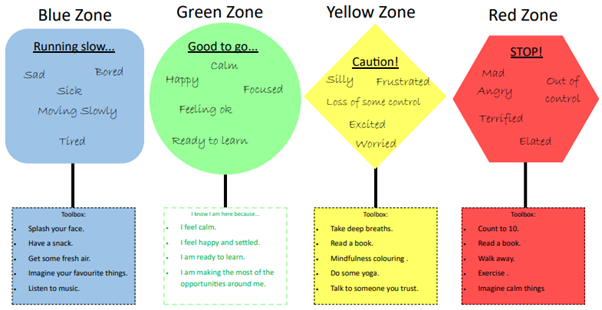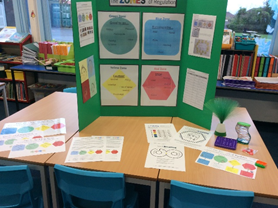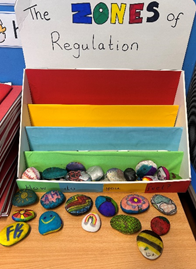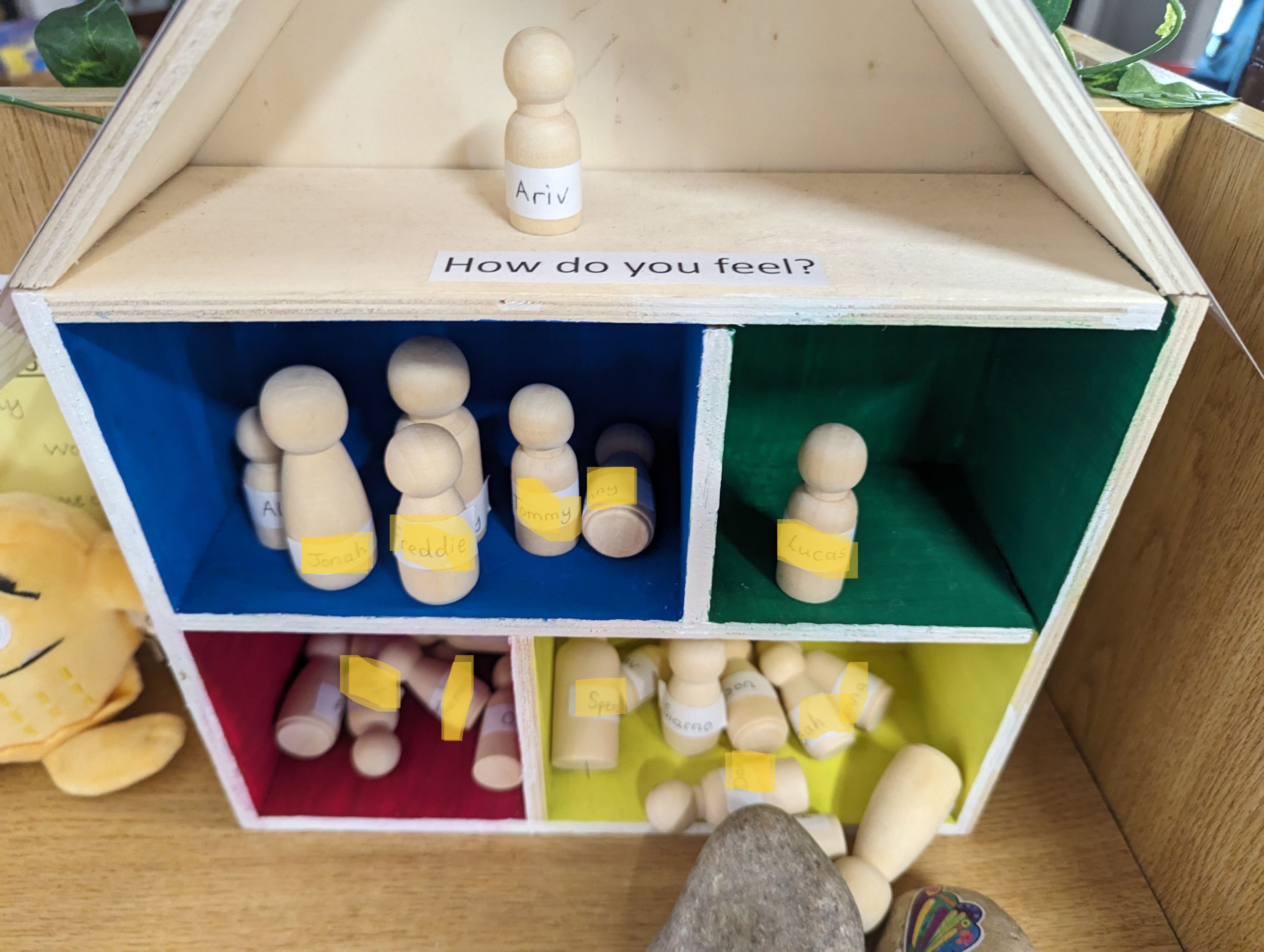Zones of Regulation
About Zones of Regulation
At Cloverlea Primary School, we recognise the importance of promoting positive mental health and emotional wellbeing to our pupils, staff & families. By implementing the Zones of Regulation curriculum we aim to teach our pupils to identify emotions in themselves and others and provide them with bank of strategies to help regulate their emotions and improve their wellbeing.
The ‘Zones of Regulation’ is a curriculum designed to foster self-regulation and emotional control. Self-regulation can go by many names, such as self-control, self-management and impulse control. It is defined as the best state of alertness of both the body and emotions for the specific situation. For example, when your child plays in a basketball game, it is beneficial to have a higher state of alertness. However, that same state would not be appropriate in the library.
From time to time, all of us (including adults) find it hard to manage strong feelings such as worry, anger, restlessness, fear or tiredness, and this stops us from getting on with our day effectively. Children who feel these emotions often find it hard to learn and concentrate in school. Zones of Regulation aims to teach children strategies to help them cope with these feelings so they can get back to feeling calm and ready to learn. These coping strategies are called ‘self-regulation’.
When children fully understand what they’re feeling, they can make sense of, and regulate their emotions much better.
The Zones of Regulation is a curriculum based around the use of four colours to help children self-identify how they’re feeling and categorise it based on colour. The curriculum also helps children better understand their emotions, sensory needs and thinking patterns. The children learn different strategies to cope and manage their emotions based on which colour zone they’re in. Additionally, the Zones of Regulation help children to recognise their own triggers, learn to read facial expressions, develop problem-solving skills, and become more attuned to how their actions affect other people.
What are the different Zones?

Blue Zone (running slow): low level of arousal; not ready to learn; feels sad, sick, tired, bored, moving slowly.
Green Zone (good to go) calm state of alertness; optimal level to learn; feels happy, calm, feeling okay, focused.
Yellow Zone (caution): heightened state of alertness; elevated emotions; has some control; feels frustrated, worried, silly/wiggly, excited, loss of some control.
Red Zone (STOP): heightened state of alertness and intense emotions; not an optimal level for learning; out of control; feels mad/angry, terrified, yelling/hitting, elated, out of control.
*There is no ‘bad’ Zone. All Zones are ‘expected’ at different times and in different circumstances. As adults, we will experience a range of zones in our usual working week and it is ok for children to experience these too.
**It is important to note that you can be in more than one Zone at a time and also that some emotions may fall into more than one Zone. We encourage the children to use their Zones both inside and outside of school, to identify their feelings and emotions and the best way to deal with them. It is completely normal to feel all four of the different zones from time to time.
We aim to help children to:
- Recognise when they are in the different Zones and learn how to change or stay in the Zone they are in.
- Increase their emotional vocabulary so they can explain how they are feeling.
- Recognise when other people are in different Zones, thus developing better empathy.
- Develop an insight into what might make them move into the different Zones.
- Understand that emotions, sensory experiences such as lack of sleep or hunger and their environment might influence which Zone they are in.
- Develop problem-solving skills and resilience
- Identify a range of calming and alerting strategies that support them (known as a ‘toolkit’.)
Children across the school are familiar with the Zones & the associated vocabulary. They are aware of different strategies and tools to help them when they are not in the ‘green zone’. Children regularly use the appropriate vocabulary to communicate with adults in school.
Each classroom has a ‘Zones Check-in’ agreed by the children, which they use throughout the day to communicate their emotions and which Zone they are in. Support can then be provided as appropriate. Classes have also devised a list of resources which they feel would be helpful for a class ‘calm-box’.
All staff (including MDA’s) have received some training and the Zones are used as the first means to support children.
Discrete teaching of the Zones takes place within our Jigsaw PSHE lessons.



How can you help your child use The Zones of Regulation at home?
The importance of language: A vital aspect of this curriculum is that all staff (and family members) know and understand The Zones language. This creates a comfortable and supportive environment for your child to practice his or her self-regulation skills. It also helps them to learn the skills more quickly and be more likely to apply them in many situations.
As a family:
- Use the language and talk about the concepts of The Zones as they apply to you in a variety of environments. - Make comments aloud so that your child understands it is natural that we all experience the different zones and use strategies to control (or regulate) ourselves. For example, “This is really frustrating me and making me go into the Yellow Zone.
- Help your child gain awareness of his or her zones and feelings by pointing out your observations. For example, ‘I can see you might be in the yellow zone…’
- Make a poster for your family to use so that language is clear and consistent. Display it somewhere for the whole family to see!
- Talk about what tool you will use to be in the appropriate Zone (e.g.: “I need to take four deep breaths to help get me back to the Green Zone.”)
- Discuss which Zone a character in a film / book might be in.
- Engaging your child in discussion around Zones when they are in the Red Zone is unlikely to be effective. You need to be discussing the different Zones and tools they can use when they are more regulated / calm.
- Teach your child which tools they can use. (e.g.: “It’s time for bed. Let’s read a book together in the comfy chair to get you in the Blue Zone.”)
- Regular Check-ins. “How are you feeling now?” and “How can you get back to Green?”
- Praise and encourage your child when they share which Zone they are in.
For further information, visit:
https://zonesofregulation.com/how-it-works/
https://www.theottoolbox.com/?s=zones+of+regulation
Another useful website for parents with lots of strategies:
